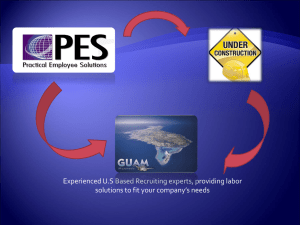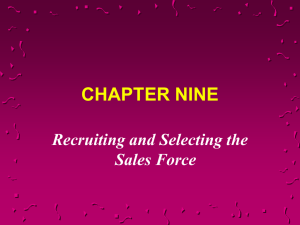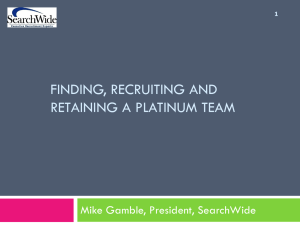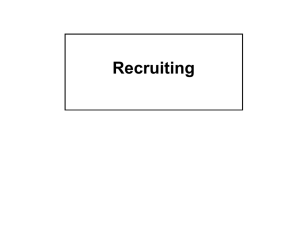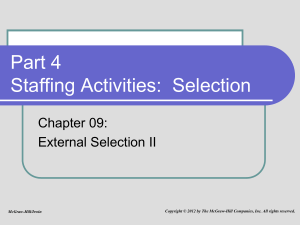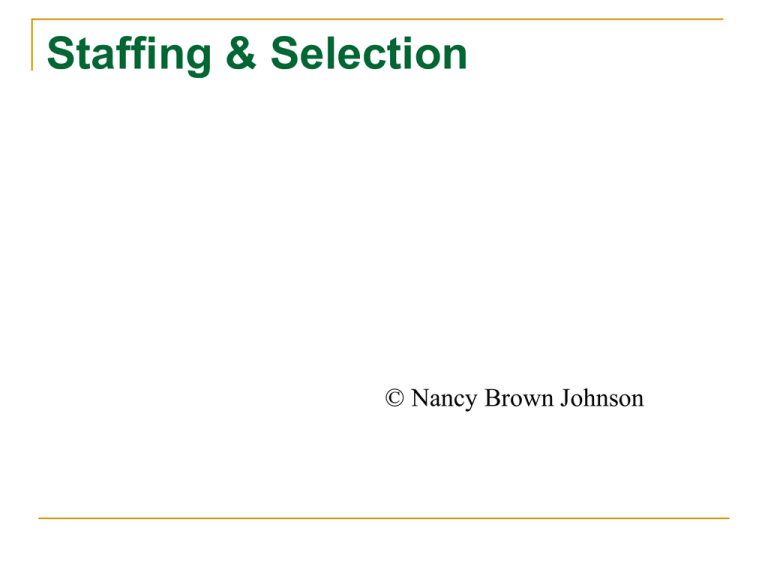
Staffing & Selection
© Nancy Brown Johnson
Staffing and Selection
Making decisions about how to get work done
in your organization
HR Planning
Forecasting Demand
Product Demand
labor derived demand
past demand (if stable)
other leading indicators
Forecasting Supply
Turnover
Promotions
Reconciliation of Supply &
Demand
Shortages
Plan for training
Counter-cyclical hiring
Wage increases
Innovative recruiting
Overtime
Subcontract
Temporary help
Other trends in staffing arrangements
Temporary Workers
Fewer benefits
Try out employees
Already trained
Tension with permanent employees
second class citizens
permanent employees threatened
lack commitment
Outsourcing
Contract entire operations
Less expensive labor
Economies of scale
Gain expertise
Oversupply
Downsizing
increased or decreased productivity
loss of good employees
commitment among survivors
Recruiting
The
process of attracting
people to apply to your
organization for work
Selection
The
process of choosing
employees for your
organization.
Traditionally
Tried to optimize job based skills
and abilities.
Today more consideration of the
match between the person and the
organization
Attraction-Selection-Attrition (ASA)
Theory
People are attracted to
organizations where they feel
comfortable.
Organizations try to select people who
fit within the organization.
People who do not fit, will leave.
ASA Results
Organizations become more
homogeneous over time
Recognizes the need to consciously
select people that fit within organization
Organizations may also need to
consciously change recruiting to attract
people who are different.
Realistic Job Previews
Recruiter's information is accurate.
Realistic Job Preview
Vaccination - prevents formation of
unrealistic expectations.
Choice based on accurate and balanced
information
- judging job based upon needs.
More freedom & choice
More committed when free to choose.
Realistic Job Previews
Works best when:
candidate can be selective in accepting a job offer
has unrealistic job expectations
would have difficulty coping with job demands
without RJP
Two Ways to Staff Job Recruiting
Externally - recruiting people from outside
the organization.
a. brings in fresh blood
b. costly
c. new people may hinder group morale
Second Way to Staff
Internally - moves between jobs in an
organization.
Important for organization
Affects career decisions
Can be a reward
less expensive
know more about the people
rewards past performance can enhance morale
Signaling Theory
When you go into the marketplace to buy a good or
service you may get a lemon
This is because there is information asymmetry- you
know more about the quality of what you are selling
than the buyer (e.g., you know more about your job
skills than a potential employer)
Consequently, there is the potential for adverse
selection: hiring the wrong person because you did
not have enough information
This is expensive-you could get stuck with a lemon
What sort of workforce does the firm want?
Fits with firm culture, technology, strategy,
& environment
Diversity: diverse workforce increases
innovation, less diversity better for
efficiency
Signaling Theory
Policies and practices of the firm can signal in
the labor market what type of worker the firm
wants
Screening practices
Compensation practices can help screen workers
Similarly, firms use signals that applicants
send to make decisions (where they go to
school)
Applicant self-selection: Output v. Input
Pay
Ideally what you want is for applicants to self-select
Firms use their general reputation through pay, training,
and selection practices
What types of signals would a firm send who pays above
market v. below market?
McDonalds will hire almost anyone; Toyota is hard to get
hired
Thus, it is important that firms send signals of the
type of employees they want
One example of signaling
Output based pay: pay based upon what you
produce
Input based pay: amount of time or effort
spent on an activity
Output Pay
Screening workers
induces inefficient
workers to leave
Pay
will leave when pay falls
short of next best
alternative
500
more productive workers
will go to A
A
B
5
Sales
Signals
Incentive compensation signals to potential
employees must be productive or they will not
be successful
May discourage less potentially productive
employees not to even want to work for that
firm
External environment influences
Labor market - loose/tight markets affect
abundance of candidates
Legal - legal concerns salient in recruiting.
Types of Labor Markets
Local
Regional
National
International
Recruiting Sources
College Students
Walk-ins
Employee Referrals
Advertising
Job Fairs
Private Employment Agencies
Public Employment Agencies
Effectiveness of Methods
Two ways to judge effectiveness
Does technique generate good candidates?
Does technique generate good employees?
Effectiveness of Recruiting
Newspapers and other advertising generates
most candidates
Referrals and rehires of previous employees
have best attendance & performance
Informal techniques appear best: employee
referrals, rehires & walk-ins.
Selection
Selection is the process of determining which
individuals will staff the organization.
Trying to find people who will best staff the
organization.
Includes: interviewing, tests, weighing
education & experience, recommendations
Good Selection Pays Off
25% of firms spend at least $1,000 for
salesperson
50% - $1000-$5,000.
Most employees don't pay back salary for a
year.
Wrong person can cost 3½X their salary.
Selection Instruments
How to decide whether they are useful.
Reliability
Am
I measuring the attribute
consistently?
Reliability
test-re-test: give people same test at two time
periods
parallel or equivalent forms: give different tests
that measure the same thing
internal consistency: a single test is subdivided
to see if people respond in the same way.
Inter-rater reliability: do different raters rate
consistently
Validity
Validity - are you measuring what you
want to measure?
In Selection: Does our selection
instrument predict job performance?
Use statistical techniques to correlate the
score on the test/interview with job
performance
Key Definitions
Predictors - personnel
selection devices.
Interviews
Ability Tests
Recommendations
Criterion - variable
used to measure job
performance.
Turnover
Absenteeism
Productivity
Performance Appraisal
Utility
Is the payoff from implementing new predictor
worth it?
Weighs the potential benefits against the
potential costs.
Utility of selection devises depends whether it
improves the quality of individuals selected
over what they would have been had the
devise not been used.
Utility= quantity X quality - cost
Quantity = Number People Selected/Year
Quality = validity coefficient (how useful is the test?)
What proportion of those selected considered
successful?
What is good job performance worth?
What is the variation in good & bad job
performance
How selective can you be?
Cost = N(C) What does the selection test cost?
Changes in Cut Score
False positive-test says to hire but
it was a mistake
False negatives-test says not to
hire but would have been good
employee
Raising Cut Score
Decreases
false
positives
Increases
false
negatives
Job Performance
False
Negative
Good
Good
False Positive
Test Score
Interviews
Most frequently used and most controversial
method of selection.
Other functions: public relations,
organization communicates what it has to
offer the applicant, and can fill in gaps in
application blank.
However, recent evidence suggests that individual
interviewers may be highly accurate in predicting job
success
Interviews Unreliable and Invalid
Difficult cognitive task:
manage conversation
listen
process information
remember
Improving Interview Validity
Restrict the use of interviews to the KSAs that
interviews can assess most effectively:
personal relations, sociability & citizenship
Use structure - consistent information from
applicants
Job related questions - direct and specific
information about the job.
Behavioral interviews ask about how applicants
have performed jobs or handled problems in the
past
Situational interviews: provide a scenario typical of
the job and then ask how to handle it
More Improving Interview Validity
Formalize scoring - rating scales on a series
of characteristics.
Team approach - several interviewers as a
group interview the applicant. Train the
interviewer
1. accurately receive information
2. critically evaluate information
3. regulate their own behavior in asking questions.
Applications
Used to get person's background &
experience
minimum requirements
comparing their strengths and weaknesses
EEOC guidelines recommend against certain
questions with adverse impact.
The questions need to be job related.
Lying
Applications were compared with factual
data.
25% listed previous employers that said they were
never employed
25% disagreement on reasons for leaving
57% duration of previous employment
72% on salary
References
Validity
Misuse and Bias
Weighted application blanks - scoring of
application blank.
Weight questions related to job success
Must insure no weights for age, sex and marital
status.
Ability Tests
Intelligence tests - yield a single intelligence
score.
Mental ability tests - multiple scores: verbal
work fluency, math, spatial relations.
Relatively high validity
Personality Tests
Personality - unique characteristics that
define an individual.
determines individual's pattern of interaction
Personality not related to job performance
except for some situations and for some
purposes
tests don't identify dimensions important for job
performance
Combining Methods
Multiple hurdle - Each test represents
hurdle and if fails any level then don't get job.
Advantage - inexpensive
Compensatory - all tests given to everyone.
Exceptional performance may offset poor
performance on another.
Advantage - higher validity.
Probationary Period
Probably the best way is to try people out
Internal labor markets use to some degree by
not promoting those who are not deemed
worthy
Costs: you have to spend resources selecting
and training
Workers may work hard just in probationary
period
Maybe harder to get rid of employee following the
probationary period
Credentials as a signal
MBA from a top notch school maybe just
getting in to that school
Signals desirable talents
However, applicants will figure this out and
start getting MBAs
Thus, there is noise and might require
additional screening
Summary
Recruiting & Selection extends beyond just
finding the right skills for the job
Includes signals that you want to send that
may attract and retain certain types of people
Must screen to work out noisy signals
Improves validity

